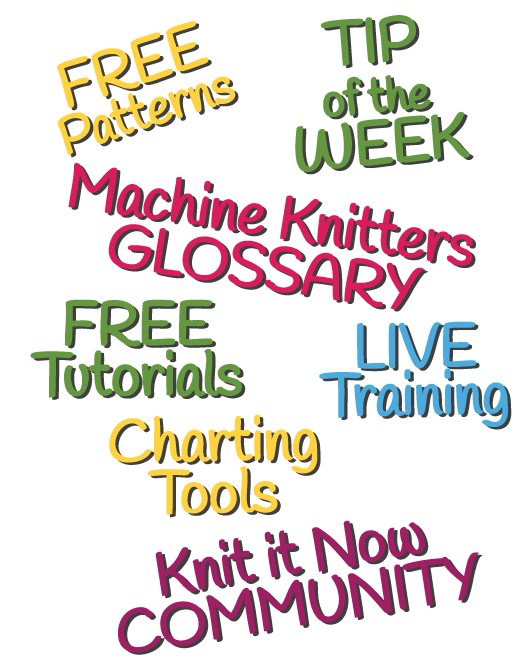Demystifying Buttons and Levers on any machine - Replay Live Archive
Delve into the essential mechanisms that drive stitch patterning, whether manually selecting needles or utilizing automatic features.
Gain insights into how these buttons and levers shape your knitting experience, empowering you to create intricate designs with confidence.
Gain insights into how these buttons and levers shape your knitting experience, empowering you to create intricate designs with confidence.
Log In
If you need to join our site - Its FREE and easy.
Please Login
Before you can watch this replayed event, you must login.If you need to join our site - Its FREE and easy.
Links mentioned in the Meeting
Multi-Color Slip
2 Color Slip (2 color Jacquard)
Textured Stripes with Slip
Classroom: Pintucks
Free Pass
2 Color Slip (2 color Jacquard)
Textured Stripes with Slip
Classroom: Pintucks
Free Pass
Slip Cast on
Coming soon
Coming soon
Skill Builder: Slip Stitch
- Instruction
- Practice Exercises
- Stitch Patterns
| Mette H from Wawa ON |
| Mette H Yes I can hear you |
| Mette H yers |
| Mette H did I miss this? |
| Clare S Thank you! |
| Jodi M Thank you Sue for all you do. |
| Sue J see you next time! |
| Kathy P Very enjoyable...thank you. |
| Joy G Thanks Sue and Matt!! ð ð |
| Maurie H Thank YOU |
| Elaine R Thank you. Always good information. |
| Celest M Great session! Thank you. |
| Doris H Thank you Sue |
| Doris C this was fun! thanks |
| Tina B Thank you, it is always a pleasure |
| Christine P Thank you! |
| Matthew F Thank you for all being members... and support |
| Pauline P Brilliant. Thanks Sue for another inspiring topic. See you on Saturday at Office Hours. |
| Cherie S Thank you Sue and Matt-- another great session! |
| Joy G Does |
| Joy G Dies anyone have a Singer or Superba fixed double bed? |
| Rhonda I Great information. Thank you so much! |
| Pauline P Sounds really good Sue. Thanks. |
| Marjorie M Very general groupings. |
| Barbara L Austria :) |
| Elaine R Pat, I think Canadians are N.Americans. |
| Pauline P And the UK? |
| Karin R I´m not on the map I think? |
| Pat Y You forgot Canadians ! |
| Matthew F really cool seeing everyone |
| Matthew F The map is live... |
| Tina B Yess, i would like to see the map, Matt |
| Matthew F The Mapp? |
| Tina B with a backing the foats are sealed. |
| Tina B Yes, that marker row, i forget that often, and regret that every time. |
| Karin R baby´s fingers could get tangled and injured in the floats, I would not recommend it for baby knits! |
| Elaine R That would look great with a cable trim. I'm thinking easy baby afghan! |
| Karin R for double bed jaquard I always use very fine yarn, it´s not too thick and I can do fine details in the pattern. Love it but it´s not easy to knit |
| Matthew F or https://knititnow.com/stitch |
| Matthew F https://www.knititnow.com/knit/stitchlibrary.cfm |
| Matthew F these are located in our stitch pattern library |
| Kim R When you looked in patterns, where is that? I donât have that at the top |
| Karin R usually those decorative floats are short (so not too risky to get caught and ripped out), although there are patterns with long floats and putting them on a needle a few rows later, too |
| Doris H Hi, sorry to be late |
| Doris C ok better - got it |
| Doris C brother and knit king |
| Elaine R Doris C.: A & B are the same on Bro & Silver. The highest letter is hold on both brands. The middle is different for some stupid reason. ð± |
| Tina B Silver reed punchcard machines preselect in the drums, but that does not appear for the eyes. |
| Jenny M B Hello all! Sorry to be late on parade:-( |
| Doris C newbie here... where is the C position? no i see a b D |
| Tina B And look over your bed after ripping out and other manual manipulations, that the needles are EXACTLY in b pos. |
| Pauline P What is the function of the middle position. Is it C position? Thanks. |
| Tina B long 6 years lol |
| Karin R I totally agree with Tina! |
| Elaine R Love the cards!!! |
| Tina B These technic reference cards are great. |
| Tina B hei from Norway |
| Tuula P Hello! From Finland Tuula |
| Doris C i hope to be at the next one. this is the first time going live with you |
| Matthew F we can do the map... when you are ready give me the word! |
| Susi W Susi from Paris IL |
| Mary Ann B I was there and really enjoyed it. |
| Cherie S Hello from BC, Canada |
| Joy G Yes I was there ðð and will hopefully be there this Saturday too... It was really good!! |
| Pauline P Yes, I joined and it was great. |
| Jodi M I was unable to get into the Saturday office hours...I will try again. |
| Pat Y Hello ,from Cloudy Nova Scotia |
| Mary Ann B Mary Ann from Burnsville MN |
| Ronda H Hi from Post Falls, Idaho |
| Kathy P Hello from Colorado |
| Maurie H Hi from Mississauga, Ontario |
| Loretta M Hello from Tulsa! |
| Doris C hello Doris from NY |
| Matthew F we can do the map today!!! |
| Pauline P Hello Matt - great that you're here. |
| Yanna O Hi from Philadelphia |
| Joy G Hi Anne, I'm in the middle lol |
| ANNE R Joy I am in the north of France |
| Nosub N Matt is in the house |
| Karin R Hi from Germany! |
| Pauline P Welcome Rhonda and any other new members. Great to see you. Pauline |
| Susan B Hello from Oklahoma |
| Ruthanne (Annie) B Hello from Springfield Oregon |
| Rhonda I Hi from Oregon. I'm a newbie. :) |
| Elaine R Elaine from North Dakota |
| Pauline P 6pm here Sue. Pauline |
| Pauline P I'm from Godalming, Surrey, UK Pauline |
| Joette Z Here from sunny Pittsburgh |
| Joy G Hi Hello from France, whereabouts are you? ð¤ |
| Pauline P I love your top Sue. Did you knit it? Pauline |
| Pauline P Hello Sue and everybody, great to be here. Pauline |
| hello from France! hello from France |
| Pauline P I'm in now. Thanks Sue. Pauline |
| Sue J pauline, if you are seeing the chat, click the yellow/orange button, then click play on the video |
| Pauline P Hello Sue, I haven't got a link to join. Could you send one please. Thanks. Pauline |
| Sandra C Hi from Maine.. |
| Joy G I'm here, from a very soggy France!!... |
| Sue Jalowiec hello! We'll be starting in a few minutes |


